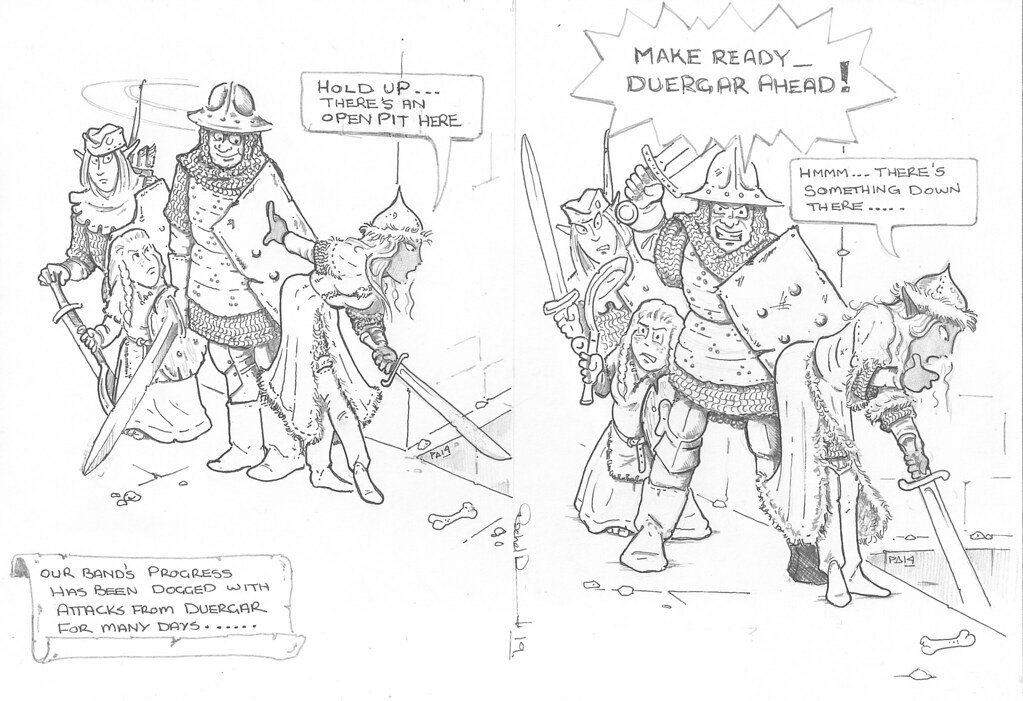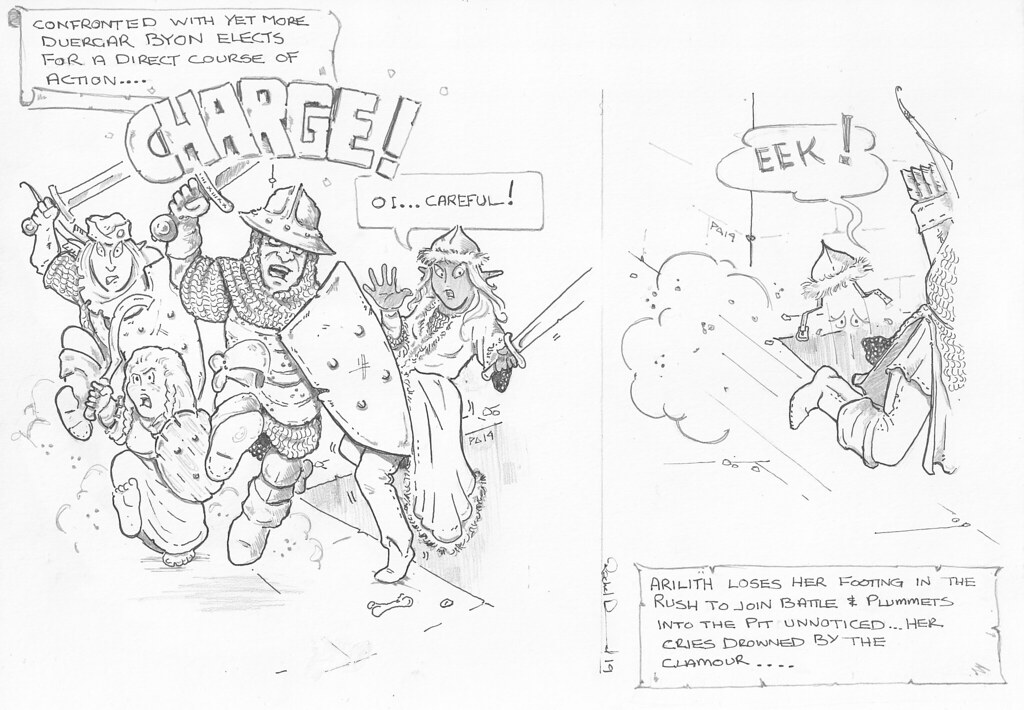

First Edition Fantasy Roleplaying Game
Get The Game
What is Classic Adventure Gaming?
Classic Adventure Gaming is not a Roleplaying Game. It is not "OSR", even if it uses rulebooks the OSR also claims. It is the style of gaming presumed and presented in the 1E PHB and DMG which was common before a playacting style of "roleplaying" grew into a new normal. It rejects the term "roleplaying game" or "RPG" because today those names firmly convey implicit expectations running contrary to practices of successful adventure gaming.
We start with what adventure gaming is not to clear the mental decks of unhelpful presuppositions, before explaining what it is.
Classic Adventure Gaming prioritizes the following:
These principles are all found in the 1st edition advanced PHB and DMG (and I strongly recommend advanced forms of the game for use with it), although they fell out of fashion as a greater number of hobbyists more comfortable with playacting than rigorous gaming, joined the hobby. Adventure gaming carves this early style back out of and away from the more common style practiced today, that openly discourages many elements that make it great. It is not for every table or every group, but for those it suites it is irreplaceable. If you and your group see an activity in the pages of the the book that play never seems to quite capture (and you wish it did), try running a campaign based upon these principles and see if the game becomes more enjoyable and engaging.
We start with what adventure gaming is not to clear the mental decks of unhelpful presuppositions, before explaining what it is.
Classic Adventure Gaming prioritizes the following:
- The players and DM are fundamentally interacting with each other, as people around a table (virtual or otherwise), not as the controllers of PCs and NPCs. No player is ever required or expected to supersede their own personality at the table with a fictional one.
- Players are expected to get better at the game and demonstrate a growing mastery of its rules in play. If someone is playing their 10th first-level character in a similar fashion to how they played their 1st first-level character then something is amiss.
- There is no expectation players will act at the table as if a game were not occurring; players are expected - not discouraged - to use what the modern hobby mistakenly disparages as "metagaming". A player who knows that fire prevents trolls from regenerating but declines to use it because "my character doesn't know that" is roleplaying instead of adventure gaming.
- Conversely, GMs must not metagame - because a GM has perfect knowledge, they must limit themselves within the knowledge, goals, abilities, resources, and quirks of the NPC or monster they are running at the time in order for a functional game to occur. This is almost the exact opposite of how most roleplaying games view the player-GM dynamic, and an example of how character-first roleplaying flipped the playstyle in a 180 away from how early games ran.
- Adventure gaming is campaign based; the idea of one-shot games is foreign to adventure gaming. A game world exists and persists apart from any group of characters. When combined with the expectation that players grow in mastery of a set of rules, a single set of rules is used for very long periods of time (if not indefinitely) so that players gain enough time in a single ruleset to understand it thoroughly as opposed to a superficial understanding.
- Because a GM is comfortable with highly experienced players, rules tinkering for tinkering's sake, or perhaps to artificially reintroduce an atmosphere of player uncertainty due to ignorance, is discouraged. GMs choose rulesets they already agree with the basic principles and presuppositions of the author, so that everyone can get on with the act of playing. High level play is embraced, it is the goal of every campaign.
- Nobody is trying to tell a story. A GM writes places and situations; if a future is written, it is the future of what will happen in that location or what those NPCs will accomplish if the players choose not to engage with it or them at all. No attempt is made to pre-determine the course of what will happen if the players decide to engage with that content. Because the GM has determined the goals, resources, abilities, local geography, and "personality" of any NPCs at a location, they have all the tools necessary to react believably and distinctly to whatever actions or plans the players may devise at the time of contact.
- Player agency is paramount. The burden of what course of action is taken is on the players, not the GM. Adventure gaming is not well-paired with a table made up entirely of passive players, regardless of how excited a GM may be to try it. Many tears occur when a GM attempt to run an adventure game with players who really want the GM to tell them what they will be doing tonight, with players making only minor decisions through the course of the evening but otherwise seeing if they can succeed at the goal a GM has set before them. It is tailor made for groups having a minimum of one player who likes to make decisions. Not everyone has to be a decision maker if the rest of the group is comfortable with allowing a minority of however many to perform the role a GM performs in a more normal campaign of deciding what the groups course of action will be for a gaming session.
- A GM accepts that world building and location/scenario writing is a parallel but separate hobby to the game itself. GMs enjoy worldbuilding for its own sake. There is no feeling that time spent devising locations and NPCs is "wasted" if players do not interact with it. Instead, because the GM has written out the effect of players not engaging with that content at all, the game world changes accordingly and seems to the players to move even where they've not personally intervened.
- As players develop their mastery of the ruleset, the pace of play becomes much faster than most roleplaying game groups experience at the table. The ideal all participants are aiming for is a tempo approaching a ping-pong game, where the GM is delivering information to the players who act or react to it quickly without negotiations over the information.
- Unlike in many RPGs, 1st level characters do not have an at-will 9th level time stop spell they can use any time they would prefer more info to make a decision. Everyone accepts that some decisions made will result in less than ideal outcomes because the game continually moves forward without time to reflect if circumstances aren't entirely in the PCs' control. But this results in more exploration, more encounters, and faster advancement in the aggregate.
- Adventure gaming is not a low-treasure, "magic is rare and wonderous" affair. "Mudcore" gaming as personified by low-resource, "realism" games such as HARN are thematic mismatches. Player agency requires ample player resources, and the GM is not intimidated by players rapidly growing in wealth, power, and independence as the early game is escaped. Early games were light on built-in character class powers because it was expected the PC would have several magical items giving an ever-changing de facto suite of "character powers" that would morph with time as items were used up (or destroyed) and replaced with new and different items.
These principles are all found in the 1st edition advanced PHB and DMG (and I strongly recommend advanced forms of the game for use with it), although they fell out of fashion as a greater number of hobbyists more comfortable with playacting than rigorous gaming, joined the hobby. Adventure gaming carves this early style back out of and away from the more common style practiced today, that openly discourages many elements that make it great. It is not for every table or every group, but for those it suites it is irreplaceable. If you and your group see an activity in the pages of the the book that play never seems to quite capture (and you wish it did), try running a campaign based upon these principles and see if the game becomes more enjoyable and engaging.
Extraordinary Delving and Cartography Co. (Part 1 & 2)
I've been playing in my brothers 1e (with houserules) adventure along with my sister-in-law and a couple of friends since the Christmas holidays. During sessions I doodle some of the action and I've started to develop these into a strip charting the party's progress. I shall be sharing these in this thread - updates will be when I get the time to put pen to paper. Should be noted that these are "cartoons" and I'll be using some artistic license but the spirit of what happens at the table will always be there...
Party:
Byon of Athfort
Human Fighter - Level 3
Aeife Green-oak
Halfing Druid - Level 3
Ellodin Afoncoed
High Elf Fighter/MU - Level 2/2
Arilith Dorchabas
Drow Fighter/MU - Level 2/2
Gorimm (NPC)
Dwarf Cleric - Level 3
Part 1 - Hollow Hills
Background:
The party have been hired by a Whitehaven noble family to rescue their son whom they believe has been kidnapped by a rival family and taken to the port town of Finwyrm to be sold into slavery and taken overseas.
The party have left the town of Whitehaven and to reach Finwyrm they would either have to cross a mountain range or take a very long route around them. At the foot of the mountains they came across a settlement of gnomes who had been troubled by bands of goblins and hobgoblins who had taken up residence in an old deserted hillfort. During the clearing of the hillfort the party found an old map which showed a series of tunnels and passages leading through the mountains themselves. They have been in these passages for some days now their progress being dogged by increasing numbers of Duergar. They have lost the cleric Gorimm during one fierce melee and although not finding his body believe him to be dead. We join them as they reach a junction in the passage. An open pit is evident in the secondary passage and further down it are fallen boulders where some of the walls have collapsed.....
Arilith on point Ellodin guarding the rear.


Note: During the course of the action Arilith, standing right at the lip of the pit, had to make a dexterity save or loose her footing. A roll on d20 of her dex score or under was required to be successful. She has a dexterity of 17... I rolled an 18.
Party:
Byon of Athfort
Human Fighter - Level 3
Aeife Green-oak
Halfing Druid - Level 3
Ellodin Afoncoed
High Elf Fighter/MU - Level 2/2
Arilith Dorchabas
Drow Fighter/MU - Level 2/2
Gorimm (NPC)
Dwarf Cleric - Level 3
Part 1 - Hollow Hills
Background:
The party have been hired by a Whitehaven noble family to rescue their son whom they believe has been kidnapped by a rival family and taken to the port town of Finwyrm to be sold into slavery and taken overseas.
The party have left the town of Whitehaven and to reach Finwyrm they would either have to cross a mountain range or take a very long route around them. At the foot of the mountains they came across a settlement of gnomes who had been troubled by bands of goblins and hobgoblins who had taken up residence in an old deserted hillfort. During the clearing of the hillfort the party found an old map which showed a series of tunnels and passages leading through the mountains themselves. They have been in these passages for some days now their progress being dogged by increasing numbers of Duergar. They have lost the cleric Gorimm during one fierce melee and although not finding his body believe him to be dead. We join them as they reach a junction in the passage. An open pit is evident in the secondary passage and further down it are fallen boulders where some of the walls have collapsed.....
Arilith on point Ellodin guarding the rear.


Note: During the course of the action Arilith, standing right at the lip of the pit, had to make a dexterity save or loose her footing. A roll on d20 of her dex score or under was required to be successful. She has a dexterity of 17... I rolled an 18.

